Three faces wears the doctor:
When first sought,
An angel’s and a god’s the cure half-wrought;
But when, the cure complete he seeks his fee,
The devil looks less terrible than he.– Unknown (quoted in Bartlett’s Familiar Quotations)
Buenos Aires – A few weeks back I ran a post about my sausage making and meat curing class. It was a short, five session class, that covered the basics of the processes, and the different styles of sausages and cured meats. From there, it’s just recipes… I hadn’t forgotten about it, I know a couple of people wanted to hear more, but only the first type, the fresh chorizos, were ready to post about within a day of making them. Everything else needs to cure – so I’ve had chorizos colorados hanging up curing, and as of yesterday, a bondiola was added to the mix. While I don’t have a nice, dark, cool, basement, I do have a center, kitchen patio, that has its shaded parts, and keeps nice and cool. It seems to be working, and, we’ve just delved into the first of the cured sausages…
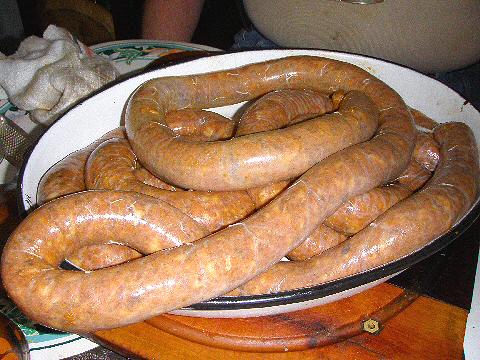
Just Stuffed – the sausages are ready to be tied off and then cured, a relatively simple process that involved leaving them in a cool, very humid spot for 48 hours, and then hanging them up for 15 days in a semi-humid location. If you look back at the post on the non-cured version, you’ll see these are far redder in color – there’s a ton of paprika in them.
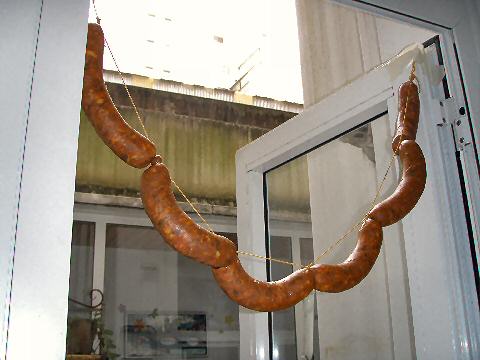
The best I could come up with was the doorway to my kitchen patio – it doesn’t get any direct sun, it stays cool, there’s good air circulation, and while humidity’s been pretty good, I used a spray bottle of water and misted them every few hours when I passed by to prevent the casings from drying out too fast.
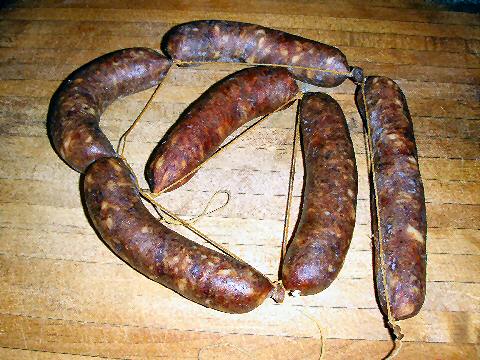
After 15 days, the meat cures and turns darker, the sausages are fairly firm, and they’ve got a fine white mold growing on them – much like you would see in any good sausage shop – a natural part of the process.
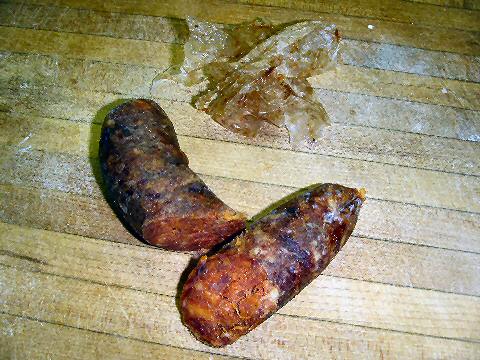
The casing does, indeed, dry out, and, just like a salami or other long cured sausage, you peel it off. These can be eaten as is, and they’re fine that way, though I found them a little soft still for that – perhaps in another week or so. In the meantime, I’ve always liked cured chorizos sliced and cooked…
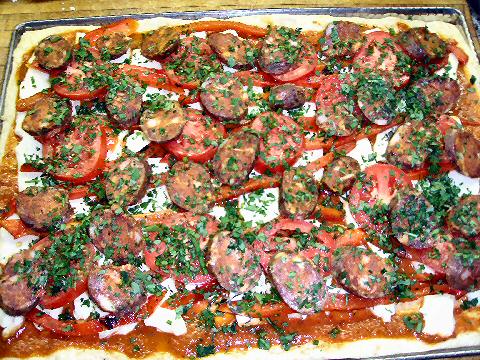
…and I thought, they’d make a great topping for a pizza, no? So a nice multi-grain crust, spicy roasted tomato sauce, fresh tomatoes, roasted peppers, herbs, and slices of the sausages. I tried a local cheese called cuartirolo which has a nice, slightly smoky flavor.
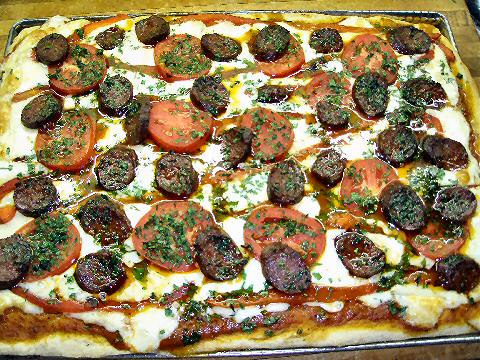
The flavors, great. The cheese, melts a bit too much, it was nearly liquid, and the crust was barely even done, which made a mess. Re-do… with a better cheese for this, though I did love the flavor combination.
Did you use any kind of nitrate with these?
Absolutely – a mixture of common salt with some sodium nitrate and a little bit of potassium nitrite (1 kilo:60 grams:6 grams), plus some polyphosphate to help preserve the color (6 grams). Pretty much impossible to really properly cure meat over several weeks without nitrates…
Hey Dan do you do delivery? 🙂
My that looks good.
Yes, delivery please! If you just seal them up in a vacuum packed plastic bag, I’ll bet they get past U.S. Customs. Think of the marketing angle. Authentic Argentine sausage made by a nice Jewish boy from B.A.
Thanks, that’s what I was thinking but wasn’t 100% sure. I’ve seen a few recipes in a local cookbook without those and they seemed a bit sketchy. I haven’t seen polyphosphate on many recipes, is it really neccessary? I mean I thought nitrates/nitrites preserve the color just as well. (from what I’ve read)
And where would one acquire sodium nitrate? I think I’d like to try my hand at pastrami or corned beef before chorizos.
I bought them all at one of the chemist’s shops near to the Facultad de Medicina here.
[…] that I’d stopped making sausages and such after my first flurry of posts on fresh chorizos, cured chorizos, merguez and summer sausages. But no, I’ve continued to make some of those and do a little […]